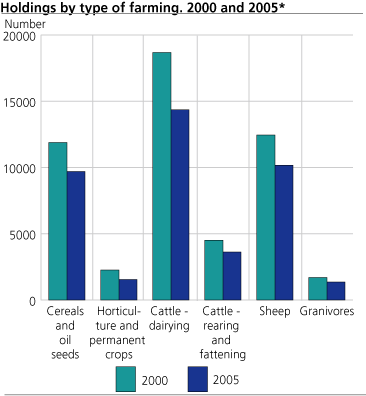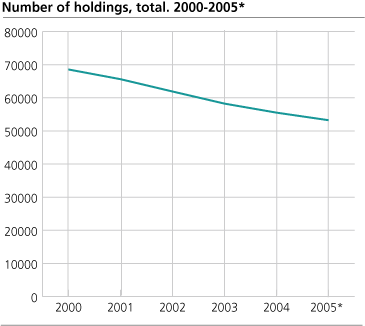Content
Published:
This is an archived release.
Fewer and larger farms
Preliminary figures from Statistics Norway show that the number of holdings with agricultural activity dropped by 2 300 to 53 200 from 2004 to 2005. One out of five farms has been settled during the last 5 years, while the size of the agricultural area in use has been fairly stable.
On average, the number of farms decreased by 3 100 each year from 2000 to 2005, corresponding to a yearly decline of 4.5 per cent. The average size of farms increased from 152 decares in 2000 to 195 decares in 2005.
Three types of farming dominates
The holdings can be classified by type of farming and economic size. The present classification system allows for comparison with the EU-countries, and is based on standard gross margin as common measurement for various outputs within agriculture. There are three dominating types of farming in Norwegian agriculture: Cattle - dairying, sheep and cereals and oil seeds. These three types of farming comprise to thirds of the agricultural holdings. Both the number of farms with plant production and farms with livestock has been reduced the last 5 years.
Fewer holdings with livestock
From 2004 to 2005 the number of holdings with pig and poultry fell by 20 per cent to 1 400 holdings. In 2005, 14 400 holdings was classified as holdings with dairy cows, a fall of 25 per cent from 2000. The average herd increased from 13.5 cows in 2000 to 16.1 in 2005. 18 per cent of the sheep farmers have stopped raising sheep since 2000. In the same 5-year period, one out of three holdings with horticulture dropped out, and the number of holdings with cereals and oil seed were reduced by 18 per cent.
Elder farmers
In 2005, 50 900 holdings were operated by natural persons, while 2 300 were operated by various legal persons, e.g. joint operations, limited companies and institutions. Since 2000 the number of holdings being operated by a legal person raised from 1.3 per cent of all holdings to 4.3 per cent of all holdings.
44 100 of the personal holders were males and 6 800 female ones. From 2000 to 2005 the average age of holders increased from 48 to 49 years of age. During the same period, the percentage of holders in age group under 40 years of age decreased by 3 per cent points to 22 per cent, while the proportion of holders between 40 and 70 years of age increased by 4 per cent points to 76 per cent. The proportion of holders 70 years of age and older decreased from 3.3 per cent of the holders in 2000, to 2.5 per cent in 2005. The average age of female holders was 48 years, as compared to 49 of male holders.
Tables:
- Table 1 Total number of holdings and holdings by type of holder
- Table 2 Personal holders, by age group. Per cent
- Table 3 Holdings by size of agricultural area in use and county
- Table 4 Agricultural area per holding, by county. Decares
- Table 5 Number of animals per holding keeping various kinds of animal, by county and size of holding
- Table 6 Holdings by type of farming. 2000-2005*
Additional information
Agricultural holdings on grids (1km, 5km)
Contact
-
Berit Bjørlo
E-mail: berit.bjorlo@ssb.no
tel.: (+47) 40 81 13 76


